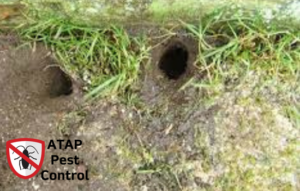Rats use their strong teeth and dexterous paws to dig burrows. In some cases, they can even chew through concrete to create entry holes. To defend yourself, you must know how rats enter homes. What do Norway rat holes look like?
Burrows and entry points come to mind when imagining rat holes. These holes can be destructive and draw attention to rat problem. Rats can damage property and spread disease. Since DIY solutions are costly and fail often, you’ll need a licensed pest control technician to control rats in Chicago.

Backyard Rat Holes
Finding rat holes can be difficult, so hire a professional. Gaps from crumbling mortar, foundation cracks, etc. Rats prefer quiet areas to nest, so doorways rarely have rat holes.
Without USA’s strict pesticide regulations, many homeowners would use strong chemicals to kill pests. USA’s over-the-counter products have lower active ingredient concentrations.
The following are signs of a rat infestation. They can climb. They can enter through HVAC and electrical access points. Rats cause:
Droppings: If you see rat droppings as you clean, this pest has invaded. Fresh droppings resemble seeds and darken over time.
Rats shed hair occasionally: Be aware of black, gray, or tan hair after it squeezes through gaps or brushes a wall.
Rats use the same routes around a home: This means they leave tail drag marks or forefingers in the dust.
Rats leave strong odors in their wake: If you smell urine, it means rats have infested your home.
Debris: Junk or wood chips indicate rat presence.
Block rat holes without trapping the rat first. If you block their holes, they may chew their way out, but if they die in your home, they decompose and stink. A decomposing body can attract harmful bacteria and pests.
Garden Rat Hole
Rats in a garden full of crops, plants, and other vegetation can cause gardeners a lot of headaches, especially around harvest time. Rats burrow under greenhouses, sheds, and decks. If you find a rat under there, call a pest control technician. Due to strict regulations on the number of active ingredients allowed in repellants, DIY solutions won’t work. Exterior bait stations are another option, but there’s a problem. Not the device itself, but how it’s used. Professionals who know everything about bait-station behavior make every case they treat successfully. The main reason a rat or rat stays in your garden is easy food access. How to deal with rats in the garden is explained below. Contact Atap Exterminators to rid Norway rat removal.
Having a bird or squirrel feeder in your garden is likely. Rats can feast on fallen seeds, nuts, and grains when wildlife eats your food. Feeding birds and squirrels will attract rats.
Rats dig burrows under man-made structures to feel more secure. If you have a deck, seal the sides and flooring. Food can easily fall between the gaps and make a meal. Protect crops and compost. Rats are opportunistic and will eat anything edible, including compost food scraps. Chicken wire under the pile may deter rats. This won’t completely deter rats, but it helps. Rats can carry up to 35 diseases, so if your crops have been nibbled, toss them.
Rat Hole Appearance
First, check the entrance for size. The entrance will be smooth and compacted from rodents entering and exiting. You’ll also see fresh dirt in a fan shape just outside the entrance where rodents excavate. Rat holes are deep. Burrows are 3 feet long and 18 inches deep. Deeper rat holes occur when rodents try to burrow under a building’s foundation or a concrete slab. The burrows have a living or nesting area made of soft debris like grass, leaves, cloth, insulation, etc. These burrows have escape holes for predators. Alternative exits may be lightly covered in dirt or hidden by objects.
Underground Rats
Yes, rats live in underground tunnels called burrows. The growing population and extensive network cause future problems. Rat burrows have one entrance/exit that leads to the food chamber. Some burrows have two exits and entrances, allowing rats to escape quickly. Even rats from different families can share burrows. Food and water scarcity may spark territorial battles. Two types of rats will burrow from these fights. The dominant and subordinate rats are weaker burrow rats. As nocturnal rodents, rats eat and are active at night.
Tunnel-Digging Rats
Rats build complex tunnels called burrows. They tunnel with limbs. Anatomically, the rat is a multitasker compared to the mole. Rats’ burrows have depth limits. The average burrow depth is half to three meters. Compare this to a mole’s one-meter-deep holes, which can clear 6 meters per hour of loose soil. The front paws have digging claws. Rats almost never dig under the foundation, but always along it, because they are limited in what they can dig. They dig under bushes and in corners for rat burrows.
Ground Rats
Rats make nests from plant materials, cotton, twigs, and manmade debris like insulation, hair, paper, and cloth. Nests may have food storage compartments. A rat’s nest has a runway trail. This is a clear path leading into and out of the nest.
Rats choose nesting spots based on food and water availability, humidity, warmth, and building materials. Under porches, in garages, in attics, between walls, in boxed-in plumbing, and in crawl spaces. nocturnal rats prefer dark places (meaning they are active at night). The Norway rat prefers to live underground in burrows or tunnels and is most likely to cause problems in your yard. Burrows can be simple tunnels or complex underground networks.
When food and water are plentiful, rats like to corporate, so multiple families use the same burrows, runways, food, and water sources. When food and water are scarce, dominating rats eat and drink first.
Weaker rats are kept far from food and water. Subordinate rats may be active during the day when dominant rats are inactive. This may explain why you see nocturnal rats in your yard during the day.
Burrowing Rats
If you haven’t seen rats, you may ignore burrows and holes. Rats are nocturnal and prefer to avoid human activity. These holes and burrows let rodents into your home. Even if you kill the rats, pheromones attract other rodents. Invaders may include birds, skunks, raccoons, and squirrels. Larger rodents only need to expand the existing holes to slide through the exposed holes.
This exposes wiring and plumbing. Rats gnaw to keep their teeth sharp, making wires and plumbing easy targets. Electrical and plumbing issues like leaks, shorts, and fires can happen quickly.
Rat holes are obvious and unsightly. These reduce your home’s curb appeal and alert neighbors and passersby to a rat problem. Rats are associated with filth, which is not something you want. Without these, you can’t sell your home.
How To Find Rat Holes
Burrowing rodents aren’t limited to rats, so the presence of tunnels and holes isn’t conclusive. Identifying rat holes is easy if you know what to look for.
Rat holes have 2-4-inch entrances. The entrance is smooth and well-packed, with loose, fresh dirt fanning out just outside. Rats’ dirt-kicking creates this pattern.
Rats like cover and protection from the elements and predators. Start on the deck and search in a straight line. Continue looking for rat holes until the entire yard is inspected.
Rat-hole Removal
Even when killing rats, hole removal is best. A few proactive measures will force rats out of your yard to find better housing. Remove the pests’ food and water sources. Lock trash cans and compost bins. Remove all food sources and fix leaking pipes and faucets.
Next, remove nesting sites. Trim trees and bushes near fences and walls and store firewood on a raised platform. Remove weeds and pest attractants from your garden.
Fill burrows with dirt and seal entrances with mesh wire or steel wool. Cover holes with chicken wire. Empty the burrows before sealing. Rats may take alternative routes to escape, creating more burrows, or suffocating, causing a difficult-to-find odor. Rotting corpses spread diseases and infections. Read What do Norway rats eat to learn more about it. Contact Atap Exterminators to killing norway rats. For more information; call us at 773-701-7705.
